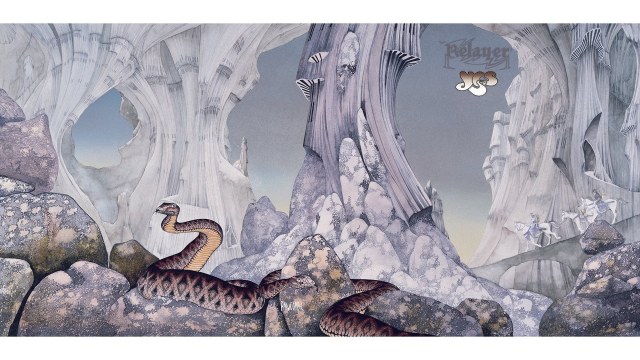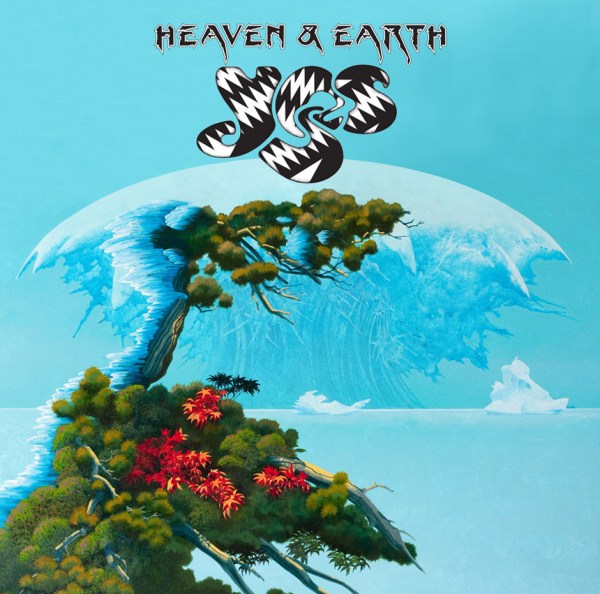 by Alison Henderson
by Alison Henderson
Tucked away along the endless leafy lanes of south east England lies a little prog oasis not many people know about. The elegant Grade II Listed façade of the period home of Trading Boundaries in deepest East Sussex gives away no clues that it is currently the location of an exhibition of probably the most famous prog artist in the world who has been joined in the celebrations this weekend by a special “old friend” of his.
The name Roger Dean is synonymous with the iconic album covers of chiefly Yes, but also other great prog rock bands such as Asia, Uriah Heep, Greenslade and now the legendary Dutch band, Focus.
Yet Dean considers himself to be nothing more than a landscape artist. That is some diminution of his role in creating the entire backdrop for a generation of prog rock lovers and perhaps being a huge influence on a very successful contemporary film but that is another story.
Living close by in the Ashdown Forest area of East Sussex, this is the third time Roger has exhibited his vast collection of work at Trading Boundaries. And here in this shopping emporium among imported Indian wooden cabinets and wardrobes, soft furnishings and desirable trinkets are currently hung some of the most iconic examples of his work.
So around every corner currently, there is another Roger Dean masterpiece to lose yourself in ranging from the huge swirling blue inner landscape he developed for Rick Wakeman’s Return to the Centre of the Earth to the intensely intricate design for Asia’s Alpha which the artist explains brought out his inherent skills as a draughtsman.
There are also the suites of logos for Yes, including the more recent dragonfly designs, and for Asia, both of which demonstrate how important it is for a band to have its own identifiable branding especially when so beautifully conceived and crafted by Dean.
Of all the works, it is the cover of Tales From Topographic Oceans which still draws the eye the most. That whole universe captured in one panorama throws up so many visual questions. Is it all meant to be beneath the sea – hence fish – or how can it be when there is a waterfall running through it – and what about the distant pyramid and the blueness of the heavens above? Like the contents of the album, the image is a mystery, a conundrum and above all else, a journey.
Oh yes, and did I mention earlier on that an old friend joined him? That would have been one and only Mr Wakeman who has supported him both evenings this weekend in Trading Boundaries’ intimate and atmospheric Elephant Cafė, (Carl Palmer, John Wetton and Steve Hackett have also played there recently), to reflect and reminisce on the past as well as contributing three musical interludes.
Well, the stories and laughs flowed thick and fast, most of them worthy of a separate post once I have deciphered the shorthand hieroglyphics I took down at speed in virtual darkness, so allow me some time to translate and share them with you some other time.
However, I can tell you this. Despite christening it Toby’s Graphic Go-Kart, Rick rates TFTO is his favourite Yes album cover whereas the artist has gone for Relayer which he said looks as though it has been painted “with dirty water”.
Also, the first time Roger showed the band an example of his work to use, Rick was admiring it and said how nice it was until the artist told him he was holding it upside down.
What came over loud and clear however was the tremendous mutual admiration and respect between the pair throughout this impromptu chat, conducted on a couple of easy chairs with the emporium’s dog occasionally wandering onto the stage and stealing the show.
And yes, Rick played – though only just when he was presented with the resident “school” piano, which in his own inimitable way, made it sound like a Steinway.
 To a backdrop of even more of Roger Dean’s incomparable works, Rick played “And You And I” using some of the original chord sequences. Well, need I tell you how absolutely sublime it sounded and still as hypnotic as the version which we all now have in our collections. Then he just made us all melt with The Meeting, that gorgeous prog hymn from Anderson Bruford Wakeman and Howe (ABWH). Rick explained he and Jon had been at George Martin’s studio in Monserrat before the volcanic eruption where they recorded the album. Both liked the idea of trying to create instant music so the melody line was what they came up with and the very first take was what appeared on the album. He made it all sound so simple, of course.
To a backdrop of even more of Roger Dean’s incomparable works, Rick played “And You And I” using some of the original chord sequences. Well, need I tell you how absolutely sublime it sounded and still as hypnotic as the version which we all now have in our collections. Then he just made us all melt with The Meeting, that gorgeous prog hymn from Anderson Bruford Wakeman and Howe (ABWH). Rick explained he and Jon had been at George Martin’s studio in Monserrat before the volcanic eruption where they recorded the album. Both liked the idea of trying to create instant music so the melody line was what they came up with and the very first take was what appeared on the album. He made it all sound so simple, of course.
Finally, to end on a more light-hearted note, he decided to play The Nursery Rhyme Concerto using the style of the great composers such as Mozart for Baa Baa Black Sheep and Ravel’s Hickory Dickory Dock. British readers will be particularly interested to learn that Twinkle Twinkle Little Star was performed in the style of Dawson, Les Dawson. Note to American readers, Google Les Dawson piano – you’ll get the general idea!
Well, that was certainly an evening you never imagined would happen. And it does not end there either. As part of the exhibition events, both top tribute band Yessongs Italy and also Focus will be playing live there in the next three weeks. What a wonderful way to celebrate a man who drew on his own unique imagination to inspire ours and also that of the music which shaped our lives.
For more information, go to: http://online.tradingboundaries.com/rdex2012











